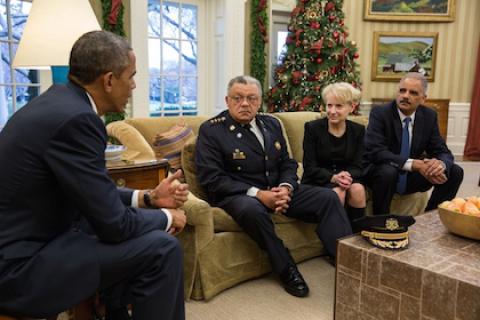This week the White House launched a plan for fixing the broken relationship between law enforcement and minority communities. The move was a response to a spate of killings of black men by white police officers — most notably the shooting of Michael Brown in Ferguson, Missouri, and the choking of Eric Garner on Staten Island in New York. Both deaths have triggered civil rights investigations by the Department of Justice.
The problem, as President Barack Obama and Attorney General Eric Holder have acknowledged, is a national one that extends well beyond the fates of those two men. But if the administration is serious about rebuilding the trust of minority communities in the legal system and police, its current proposals are not enough to help matters much.
Obama’s plan calls for investing $263 million in community policing, of which $75 million will be used to encourage police to employ body cameras. These devices are in vogue as a way to create an objective record of police-citizen encounters and find a way through the tangle of conflicting accounts that inevitably accompanies volatile incidents. Pilot programs show cameras can both curb police misconduct and protect officers against false accusations of abuse.
Much depends, however, on how they are used. Can officers turn them on and off at will? How long will recordings, which may take place in the privacy of homes, be kept? Will recordings be used only for police misconduct cases or if they contain evidence of a crime, or will they provide a backdoor for surveillance and tracking? Who will make sure that police are complying with the rules?
Even if these difficult issues are resolved, the Garner case demonstrates that video recordings are no panacea. A video of his arrest recorded by a passerby shows him being put in a chokehold by a New York City Police Department officer, and the medical examiner ruled the death a homicide. But a Staten Island grand jury decided not to indict him — symptomatic, many say, of a justice system biased against African-Americans.
The second plank of Obama’s plan takes aim at the militarization of police forces but falls short of meaningful change. Over the summer, images of cops kitted out like commandos sitting atop Bearcat armored trucks in response to protests in Ferguson focused the country’s attention on the militarization of police forces. The White House’s review of federal funding programs concluded that one program alone put 460,000 pieces of military equipment — such as assault rifles and armored mine-resistant vehicles — into the hands of police. Other programs provide federal dollars that can be used to buy equipment that local law enforcement deems necessary, with few constraints.
In the next months, Obama will take welcome steps to harmonize standards across funding programs and increase accountability. But the White House review avoids the fundamental question of whether police need military equipment in the first place and shies away from weighing the cost to community relations when cops look like commandos.
The White House established the Task Force on 21st Century Policing to provide an opportunity for developing a more comprehensive response than these single-issue fixes. It is charged with figuring out “how to promote effective crime reduction while building public trust,” said a White House official, and reporting back in 90 days.
A central issue that the task force must tackle is one that is at the heart of the Brown and Garner killings: whether police react too aggressively to low-level offenses committed by men of color. Brown was stopped on suspicion of stealing a few cigars, Garner for selling loose cigarettes. This type of policing is common across America, sometimes under the rubric of the broken-windows theory, which promotes cracking down on minor infractions as a way to reduce more serious crime. Its effectiveness is hotly debated, but it has undoubtedly strained relations between law enforcement and minority communities, which feel unfairly targeted.
Nor should the task force confine itself to long-standing issues of racial discrimination. To be relevant for the 21st century, it must cover newer concerns as well. Local involvement in counterterrorism initiatives has damaged relations with American Muslim communities. And police now have access to a range of technology, from data generated by license plate readers and surveillance cameras to the body cameras in which the White House is putting so much faith. The usefulness of these innovations and their risks to civil liberties need attention.
At least the timing is right for the White House’s initiative. The nation’s attention is riveted on policing. And with crime at all-time lows and an emerging consensus on the need for criminal justice reform, a task force may be able to make headway.
Of course, there’s no point in developing a blueprint for modern policing if it just sits on a shelf. Obama promises that this commission will be different because it has his backing. After all, the federal government exercises significant influence on local law enforcement through a variety of funding programs. The president should boldly use this leverage to ensure that the country learns the right lessons from the tragedies in Ferguson and New York.
[Faiza Patel is co-director of the Liberty & National Security Program at the Brennan Center for Justice at NYU Law School. She focuses on U.S. counterterrorism policy, racial and religious profiling, human rights and humanitarian law, chemical weapons and international law.]


Spread the word